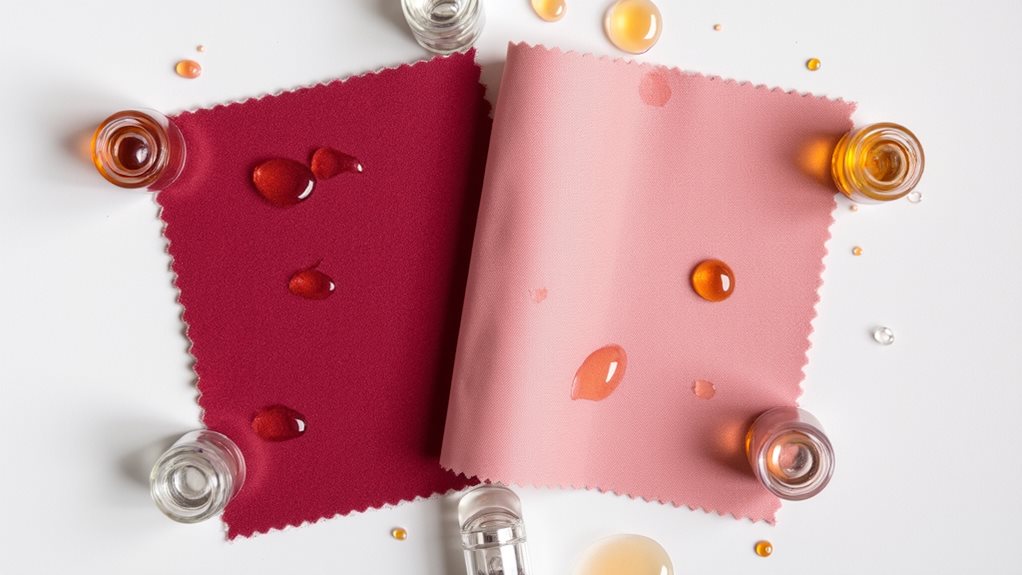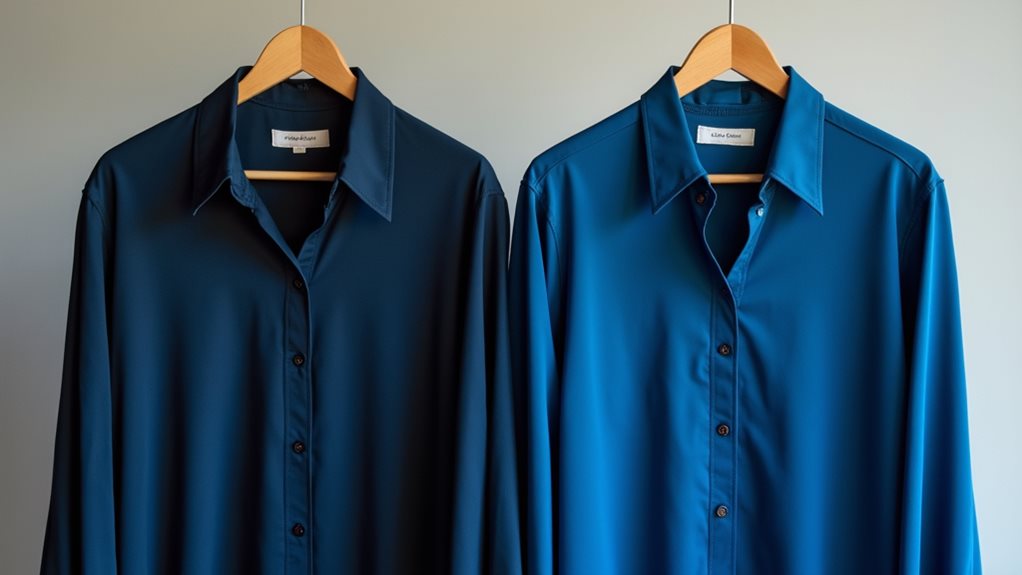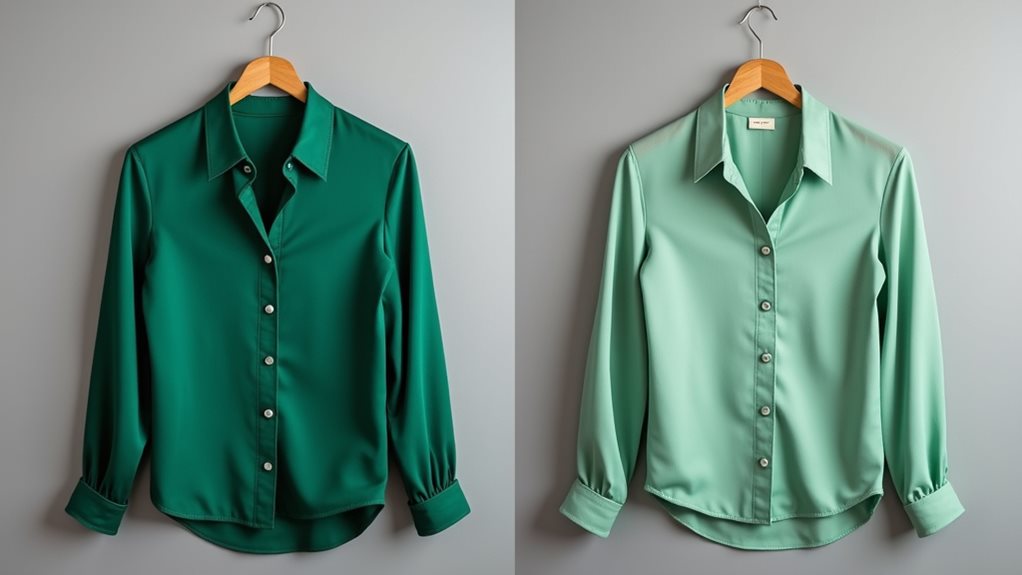Dry cleaning itself doesn’t fade colors, but here’s the catch – 95% of cleaners use dirty solvents that extract dyes from previous garments, creating that murky solution you’ve probably noticed. These contaminated fluids gradually dull your dark clothes with each visit, while reactive chemicals attack sensitive colors like blacks, reds, and blues. The good news? Clean, crystal-clear solvents like siloxane actually preserve your garment’s vibrancy, and understanding which cleaners use proper methods can save your favorite pieces.
How Dirty Dry Cleaning Solvent Affects Color Vibrancy
When I first started paying attention to dry cleaning quality, I discovered something that honestly made me a little angry – many cleaners were using dirty, discolored solvents that were literally stealing the vibrancy from my favorite dark clothes.
Here’s what happens: when dirty dry cleaning solvents circulate through the cleaning process, they’ve already extracted dyes from previous garments, creating a murky solution that continues pulling color from your clothes.
Think of it like washing your white shirt in muddy water – you’re not getting cleaner results. This ongoing dye loss means your black dress or navy suit gradually becomes duller with each visit.
The frustrating part? Clean dry cleaning fluid would prevent this fade color issue entirely, preserving your garments’ original richness and extending their lifespan considerably.
Unlike water-based washing that causes agitation and temperature extremes, proper dry cleaning with clean chemical solvents creates a gentler environment that naturally protects fabric colors from bleeding and fading.
The Role of Chemical Reactions in Dye Fading

Beyond the obvious problem of dirty solvents sits an even more insidious culprit that I wish I’d understood years ago – the chemical warfare happening between common dry cleaning fluids and your garment’s dyes.
Here’s what’s really happening: perchloroethylene and other reactive dry cleaning solvents literally attack your fabric’s color molecules, triggering chemical reactions that break down dye structures from the inside out.
This dye degradation particularly targets sensitive colors like pinks, reds, blues, and blacks, systematically destroying color integrity with each cleaning cycle.
What’s frustrating is that 95% of cleaners use these reactive cleaning methods!
The harsh solvents don’t just fade colors – they can also gradually break down fabric fibers, reducing the overall lifespan of your clothing.
The solution? Finding establishments that use chemically inert solvents like siloxane, which won’t trigger fading through unwanted chemical reactions.
When Improper Cleaning Methods Cause Color Loss

Although chemical reactions between solvents and dyes create one layer of fading problems, I’ve watched countless clients unknowingly accelerate color loss through basic cleaning mistakes that could’ve been easily avoided.
You’re setting yourself up for disappointment when you ignore these critical factors during the dry cleaning process:
- Skipping the care label – Those tiny symbols aren’t suggestions, they’re your garment’s survival guide.
- Choosing inexperienced cleaners – Poor solvent management and dirty solvents used repeatedly create dye-stripping disasters.
- Washing “dry clean only” items – Water becomes your worst enemy for delicate fabrics.
- Ignoring fabric vulnerability – Reds, blues, and blacks need extra attention with proper cleaning methods.
I’ve seen gorgeous designer pieces ruined because someone thought they knew better than the manufacturer’s instructions.
Beyond color fading concerns, many dry cleaners are transitioning away from traditional PERC solvents to safer alternatives like liquid CO2 and hydrocarbon-based solutions.
Don’t let fading become your expensive lesson!
Understanding Colorfastness and Dye Sensitivity

Since I’ve spent years examining faded garments under magnifying glasses, trying to explain to heartbroken clients why their favorite dress now looks like a watercolor painting, I can tell you that understanding colorfastness isn’t just technical jargon—it’s the difference between preserving your wardrobe and watching it slowly deteriorate.
Colorfastness measures how well your fabric’s dye resists fading when exposed to cleaning solvents, and honestly, some colors are just drama queens. Pink, red, blue, and black dyes have serious dye sensitivity issues, making them prone to bleeding or losing vibrancy during dry cleaning.
When you’re dealing with stubborn stains on these temperamental fabrics, your dry cleaner faces a delicate balancing act between removing the stain and preserving the original color integrity. The advantage of chemical solvents in dry cleaning is that they can often remove oil-based and protein stains more effectively than water-based methods while being gentler on fabric fibers.
Best Practices for Preserving Dark Garment Colors

When it comes to preserving those gorgeous dark colors that make your wardrobe pop, I’ve learned through countless “oops” moments that the right dry cleaner can be your best friend or your worst nightmare.
The right dry cleaner can be your wardrobe’s best friend or worst nightmare when preserving those gorgeous dark colors.
Trust me, watching my favorite black blazer come back looking gray taught me everything about protecting fabric quality the hard way.
Here’s what I wish someone had told me earlier:
- Choose dry cleaners using crystal clear solvents like siloxane – these preserve vibrant colors without the harsh chemical damage
- Never wet clean “dry clean only” items – I’ve seen too many dark cottons faded after dry cleaning this way
- Check solvent quality regularly – clear fluids mean no dye loss, discolored ones spell trouble
- Embrace eco-friendly cleaning methods – they’re gentler and help your garments last longer
While many establishments still rely on perchloroethylene for its proven effectiveness at dissolving oils and greases, this traditional petroleum-derived solvent can be harsher on delicate fabric colors than newer alternatives.
Your dry cleaner should be your fabric’s protector, not its destroyer!




